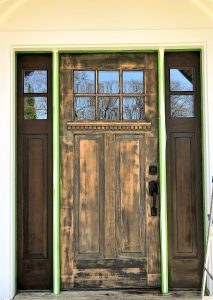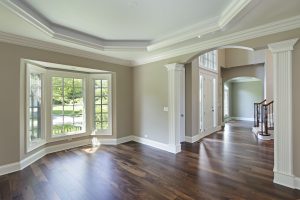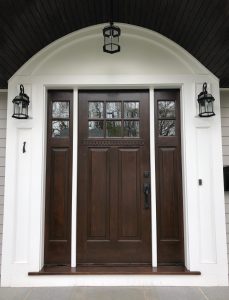Door Restoration
Mary Ellen, one of our master restorers, recently completed a door restoration. Have you ever seen a sunburned wooden door? The sun had badly burned our clients’ front door. The sun’s UV rays damage wood doors, much like they damage our skin. Years of exposure to the sun can mar the finish and wood of an exterior door. They become weather-worn and look like eyesores. The searing sun splits, fades, and desiccates raw wood-Mary Ellen to the rescue. The sun burned our clients’ door severely, but it was salvageable.
Door Restoration Process
First, Mary Ellen stripped off the damaged finish. She then sanded and cleaned the door. Sanding removes any leftover old finish that is left behind after the stripping. Sanding also smooths the surface of the door, removing any splinters or burrs. It is essential to clean the door, or any surface for that matter, after sanding. In order to have a smooth paint or varnish finish, Mary Ellen had to remove microscopic bits of dirt and dust created by sanding. 
After sanding and cleaning, Mary Ellen applied a mixture of Zar wood stain and finishing products in various colors in order to assure an accurate color match. We use Zar because their products are durable; they last for many years. Durability is extremely important for door restoration projects. Exterior doors obviously take a lot of abuse from the elements. We use products that provide excellent protection form the sun, ice and temperature fluctuations.
Zar also delivers impressive colors. On many projects, we often have to match existing exterior colors. Even when we are working on a new build out, our clients often have specific colors in mind. Accurate color matching is imperative for all of our projects. We have found that many wood stain and finishing products are durable, but have difficulty matching the existing or planned color palette of a space. Zar products provide wonderful depth of color and are incredibly durable. They always provide beautiful, enduring results for our clients.
Project Color Choices
For this door restoration, Mary Ellen needed a few colors. She used eight ounces of Early American and two ounces of Black Onyx.  For her final finish coat of color, Mary Ellen applied wax-free Shellac. After applying and mixing the colors, the door needed top coats. Mary Ellen used semi-gloss spar varnish.
For her final finish coat of color, Mary Ellen applied wax-free Shellac. After applying and mixing the colors, the door needed top coats. Mary Ellen used semi-gloss spar varnish.
Spar varnishes contain oil and they protect the wood from the elements, UV rays. Spar varnish also provide flexibility. Wood expands and contracts with heat and cold. Finishes that do not contain oil crack much more easily and consequently painted exteriors will suffer paint failure and begin chipping and peeling under the stress of the elements. Spar varnish is much more durable. It acts as sort of a sunscreen for wood. The varnish actually gets its name from our sailing heritage. The long wooden poles that hold the sails are called spars. Sailors coated spars with linseed oil varnishes to protect the wood from the rough elements of the sea-wind, salt, sub exposure, cold, heat and salt water.
Mary Ellen’s hard work and attention to detail saved the weather-worn door. It was restored and rescued from the elements. The restored door is gorgeous, a welcoming sight.
Be well,
Bill



